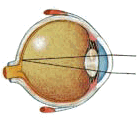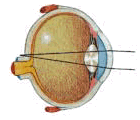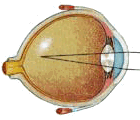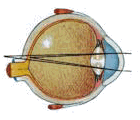|
|
|
Normal vision:
In a normal eye, light rays pass through the cornea and lens then focus
on the retina in a precise way without blurring - just as a camera lens
focuses light onto a film.

The perfect state of focusing exactly on the retina is unusual; the
average person is a little hyperopic.
Long-sighted vision (Hyperopia):

A long-sighted, or hyper-metropic eye is shorter than normal. Light
rays focus behind the retina, and close objects look blurred.
Short-sighted vision (Myopia or nearsightedness):

A short-sighted, or myopic eye is longer than normal. Light rays focus
in front of the retina rather than on the retina. Distant objects look
blurred.
Astigmatism:

Many people with myopia or hypermetropia also have some astigmatism. Caused by changes in the curvature of the cornea itself, astigmatism distorts the light rays entering the eye and prevents them from focusing clearly.
Presbyopia:
In addition to the above refractive errors, with age the lens of the
eye loses its flexibility and is less able to change its shape to sharply
focus the light on the retina. Close tasks such as reading or sewing become
more difficult. It is a normal part of the ageing process.
More about
myopia.htmlMyopia (shortsightedness)
hyperopia.htmlHyperopia (long sightedness)
presbyopia.htmlPresbyopia
(still to upload .....sorry)!!!!!